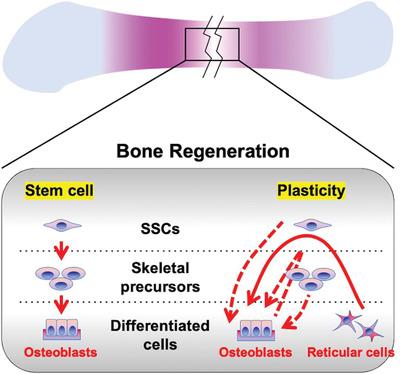Our official English website, www.x-mol.net, welcomes your
feedback! (Note: you will need to create a separate account there.)
Bone regeneration via skeletal cell lineage plasticity: All hands mobilized for emergencies
BioEssays ( IF 3.2 ) Pub Date : 2020-11-06 , DOI: 10.1002/bies.202000202 Yuki Matsushita 1 , Wanida Ono 1 , Noriaki Ono 1
BioEssays ( IF 3.2 ) Pub Date : 2020-11-06 , DOI: 10.1002/bies.202000202 Yuki Matsushita 1 , Wanida Ono 1 , Noriaki Ono 1
Affiliation

|
An emerging concept is that quiescent mature skeletal cells provide an important cellular source for bone regeneration. It has long been considered that a small number of resident skeletal stem cells are solely responsible for the remarkable regenerative capacity of adult bones. However, recent in vivo lineage‐tracing studies suggest that all stages of skeletal lineage cells, including dormant pre‐adipocyte‐like stromal cells in the marrow, osteoblast precursor cells on the bone surface and other stem and progenitor cells, are concomitantly recruited to the injury site and collectively participate in regeneration of the damaged skeletal structure. Lineage plasticity appears to play an important role in this process, by which mature skeletal cells can transform their identities into skeletal stem cell‐like cells in response to injury. These highly malleable, long‐living mature skeletal cells, readily available throughout postnatal life, might represent an ideal cellular resource that can be exploited for regenerative medicine.
中文翻译:

通过骨骼细胞谱系可塑性进行骨再生:为紧急情况动员所有双手
一个新兴的概念是静止的成熟骨骼细胞为骨再生提供了重要的细胞来源。长期以来,人们一直认为少数常驻骨骼干细胞是成人骨骼显着再生能力的唯一原因。然而,最近的体内谱系追踪研究表明,骨骼谱系细胞的所有阶段,包括骨髓中休眠的前脂肪细胞样基质细胞、骨表面的成骨细胞前体细胞以及其他干细胞和祖细胞,都被同时招募到损伤部位,共同参与受损骨骼结构的再生。谱系可塑性似乎在这个过程中发挥着重要作用,成熟的骨骼细胞可以通过该过程将其身份转化为骨骼干细胞样细胞以响应损伤。
更新日期:2020-12-22
中文翻译:

通过骨骼细胞谱系可塑性进行骨再生:为紧急情况动员所有双手
一个新兴的概念是静止的成熟骨骼细胞为骨再生提供了重要的细胞来源。长期以来,人们一直认为少数常驻骨骼干细胞是成人骨骼显着再生能力的唯一原因。然而,最近的体内谱系追踪研究表明,骨骼谱系细胞的所有阶段,包括骨髓中休眠的前脂肪细胞样基质细胞、骨表面的成骨细胞前体细胞以及其他干细胞和祖细胞,都被同时招募到损伤部位,共同参与受损骨骼结构的再生。谱系可塑性似乎在这个过程中发挥着重要作用,成熟的骨骼细胞可以通过该过程将其身份转化为骨骼干细胞样细胞以响应损伤。











































 京公网安备 11010802027423号
京公网安备 11010802027423号